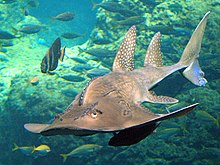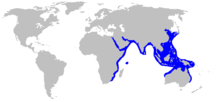Rhina ancylostoma
| Rhina ancylostoma | |
|---|---|

| |
| Scientific classification | |
| Domain: | Eukaryota |
| Kingdom: | Animalia |
| Phylum: | Chordata |
| Class: | Chondrichthyes |
| Subclass: | Elasmobranchii |
| Superorder: | Batoidea |
| Order: | Rhinopristiformes |
| Family: | Rhinidae J. P. Müller and Henle, 1841 |
| Genus: | Rhina Bloch & J. G. Schneider, 1801 |
| Species: | R. ancylostoma
|
| Binomial name | |
| Rhina ancylostoma J. G. Schneider , 1801 | |

| |
| Range of Rhina ancylostoma[3] | |
| Synonyms | |
|
Rhina cyclostomus Swainson, 1839 | |
Rhina ancylostoma, also known as the bowmouth guitarfish, shark ray or mud skate, is a
Usually found near the
Taxonomy and phylogeny
German
The evolutionary relationships between Rhina ancylostoma and other rays are debated.
In terms of classification, Bloch and Schneider originally placed the bowmouth guitarfish in the order Abdominales, a now-obsolete grouping of fishes defined by the positioning of their
Description

Rhina ancylostoma is a heavily built fish growing to 2.7 m (8.9 ft) long and 135 kg (298 lb) in weight.[3][7] The head is short, wide, and flattened with an evenly rounded snout; the front portion of the head, including the medium-sized eyes and large spiracles, is clearly distinct from the body. The long nostrils are transversely oriented and have well-developed skin flaps on their anterior margins. The lower jaw has three protruding lobes that fit into corresponding depressions in the upper jaw.[3][17] There are around 47 upper and 50 lower tooth rows arranged in winding bands; the teeth are low and blunt with ridges on the crown. The five pairs of ventral gill slits are positioned close to the lateral margins of the head.[3][18]
The body is deepest in front of the two tall and falcate (sickle-shaped)
The entire dorsal surface has a grainy texture from a dense covering of tiny
Distribution and habitat
While uncommon, Rhina ancylostoma is widely distributed in the coastal
Biology and ecology

Rhina ancylostoma is a strong swimmer that propels itself with its tail like a shark. It is
The
Reproduction in Rhina ancylostoma is
Human interactions

Throughout its range, the bowmouth guitarfish is caught incidentally or intentionally by
The
It is a popular subject of public aquariums and fares relatively well, with one individual having lived for seven years in captivity.[3][19] In 2007, the Newport Aquarium in Kentucky initiated the world's first captive breeding program for this species.[39] Newport Aquarium announced in January 2014 that the female, "Sweet Pea", had become pregnant and given birth to seven pups.[40] By February 2014, all seven pups had died.[41] On January 7, 2016, Sweet Pea gave birth to nine shark pups[42] which were eating on their own and still gaining weight by February 10, 2016.[43] Newport Aquarium later announced that the pups would be moved into a coral reef exhibit where they can be viewed by the public starting on June 24.[44] The species also bred at the S.E.A. Aquarium in Singapore in 2015.[45]
References
- ^ . Retrieved 18 November 2021.
- ^ "Appendices | CITES". cites.org. Retrieved 2022-01-14.
- ^ ISBN 978-0-674-03411-2.
- ^ a b Bloch, M.E.; Schneider, J.G. (1801). Systema Ichthyologiae Iconibus CX Ilustratum. Berolini. p. 352.
- ISBN 3-904144-16-2.
- ^ Eschmeyer, W.N. (ed.). "ancylostomus, Rhina". Catalog of Fishes. Archived from the original on April 20, 2021. Retrieved May 14, 2013.
- ^ a b c d Froese, R.; Pauly, D., eds. (2011). "Rhina ancylostoma, Bowmouth guitarfish". FishBase. Retrieved May 14, 2013.
- ^ Nishida, K. (1990). "Phylogeny of the suborder Myliobatoidei". Memoirs of the Faculty of Fisheries, Hokkaido University. 37: 1–108.
- ^ ISBN 0-8493-1514-X.
- ^ ISBN 978-1439839249.
- ^ ISBN 978-1-4398-3924-9.
- ^ PMID 27470765.
- ^ Müller, J.; Henle, F.G.J. (1841). Systematische Beschreibung der Plagiostomen (volume 2). Veit und Comp. p. 110.
- ^ ISBN 92-5-104302-7.
- ISBN 0-471-25031-7.
- ISBN 9780643109148.
- ^ ISBN 0-8248-1808-3.
- ISBN 1-86872-890-0.
- ^ ISBN 0-930118-18-9.
- ISBN 1-55209-629-7.
- ^ a b c Raje, S.G. (2006). "Skate fishery and some biological aspects of five species of skates off Mumbai". Indian Journal of Fisheries. 53 (4): 431–439.
- .
- S2CID 39996373.
- ^ Sarada, S.; Lakshmi, C.V.; Rao, K.H. (1995). "Studies on a new species Carpobothrium rhinei (Cestoda: Tetraphyllidea) from Rhina ancylostomus from Waltair coast". Uttar Pradesh Journal of Zoology. 15 (2): 127–129.
- S2CID 85869638.
- ^ Palm, H.W.; Walter, T. (1999). "Nybelinia southwelli sp. nov. (Cestoda, Trypanorhyncha) with the re-description of N. perideraeus (Shipley & Hornell, 1906) and synonymy of N. herdmani (Shipley & Hornell, 1906) with Kotorella pronosoma (Stossich, 1901)". Bulletin of the Natural History Museum, Zoology Series. 65 (2): 123–131.
- PMID 26176156.
- .
- ^ de Silva, P.H.D.H. (1963). "The occurrence of Pontobdella (Pontobdellina) macrothela Schmarda and Pontobdella aculeata Harding in the Wadge Bank". Spolia Zeylanica. 30 (1): 35–39.
- S2CID 45422870.
- S2CID 21951837.
- S2CID 31003794.
- PMID 19723521.
- .
- ^ Purushottama, G. B.; Thomas, Sujitha; Kizhakudan, Shoba Joe; Zacharia, P. U. (2022). "Catch composition, reproductive biology and diet of the bowmouth guitarfish Rhina ancylostomus Bloch and Schneider, 1801 (Batoidea: Rhinidae) in the eastern Arabian Sea, India". Indian J. Fish. 69 (3): 1-6.
- ^ Devadoss, P.; Batcha, H. (1995). "Some observations on the rare bow-mouth guitar fish Rhina ancylostoma". Indian Council of Agricultural Research Marine Fisheries Information Service Technical and Extension Series. 138: 10–11.
- ISBN 978-1-921605-59-8.
- ISBN 2-8317-0650-5.
- ^ a b "Newport Aquarium Launches World's First Shark Ray Breeding Program, Adds Rare Male Shark Ray". UnderwaterTimes. February 1, 2007. Retrieved January 22, 2009.
- ^ "Newport Aquarium's Sweet Pea, the First Documented Shark Ray to Breed in Captivity, Gives Birth to Seven Pups". Aquarium Works. Newport Aquarium. January 29, 2014. Retrieved February 1, 2014.
- ^ "Newport Aquarium says shark ray pups died". WKRC-TV. 26 February 2014. Archived from the original on 26 February 2014. Retrieved 26 February 2014.
- ^ "Newport Aquarium shark ray gives birth to nine pups". FOX19NOW. 7 January 2016. Retrieved 10 February 2016.
- ^ "Shark Ray Pups Reach Milestones". aquariumworks.org. 10 February 2016. Retrieved 10 February 2016.
- ^ Ferrell, Nikki (23 June 2016). "Rare shark ray pups to move to exhibit at Newport Aquarium". Retrieved 2016-06-25.
- ^ "S.E.A. Aquarium successfully breeds shark ray pup, a vulnerable species". The Straits Times. 5 May 2016. Retrieved 12 August 2016.

